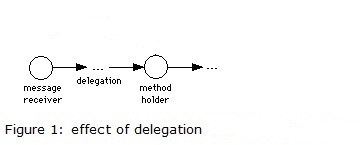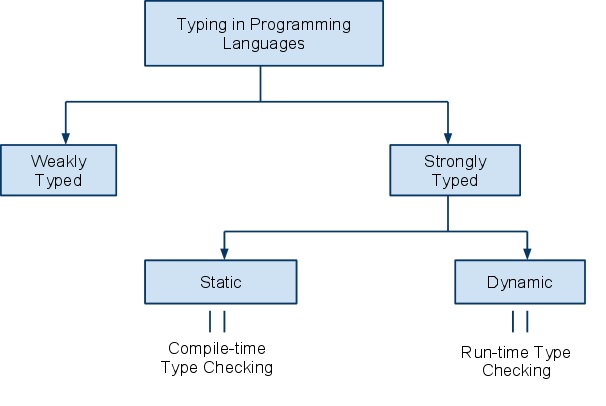CSC/ECE 517 Fall 2010/ch6 6a PC
Delegation-based programming languages
" I do not care how it is done, or who is it assigned to. If something is understood to be placed in the hands of another party, it is delegation " - 'Anonymous'
Introduction
Dictionary defines delegation as the assignment of authority and responsibility to another person to carry out specific activities.In programming context it is nothing different. It is basically entrusting an action to another agent. This term was initially introduced by Henry Lieberman in his 1986 paper "Using Prototypical Objects to Implement Shared Behavior in Object-Oriented Systems". [1] He defines delegation in object oriented languages as a programming language feature making use of the method lookup rules for dispatching so-called self-calls.
The above diagram depicts that a message receiver is asking another object (message holder) to do something on its behalf which may delegate it to someone and so on and so forth
Delegation
Delegation, is also referred to as aggregation,consultation, or forwarding. In delegation one class may contain an instance of another class, and delegate some responsibility to that class. This is also referred to as the has-a relationship. Aggregation should not be confused with composition. Both aggregation and composition are used to describe one object containing another object, but composition implies ownership [2]. Aggregation is more general and doesn't imply any responsibilities for memory management. A class which contains other classes is called a composite class, while a class being contained is called a composited or composed class [3].Delegation is a very powerful reuse technique. The provides run time flexibility. It is also called dynamic inheritance.[4]
Delegation can be implemented in many programming languages like Ada, Aikido, C, C#, C++, Common Lisp, D, E, Go, J, Java, JavaScript, Logtalk, Objective-C,Oz, Perl,Perl 6, PHP, PicoLisp, Pop11, Python, Ruby, TCL, Vorpal [5]
Example in a Java like language:
class Delegate
{
void doSomething()
{
// "this" is also known as "current", "me" and "self" in other languages
this.callMe()
}
void callMe()
{
print("I am Delegate")
}
}
class Delegator
{
private Delegate d; // delegationlink
public Delegator(Delegate d)
{
this.d = d;
}
void doSomething() {
d.doSomething() // call doSomething() on the Delegate instance
}
void callMe() {
print("I am Delegator")
}
}
d = new Delegate()
b = new Delegator(d) // establish delegation between two objects
Here calling b.doSomething() will result in "I am Delegate" being printed, since class Delegator "delegates" the method callMe() to a given object of class Delegate.
Delegation vs Inheritance
Inheritance and delegation are used in different situations in object oriented programming. These two are different concepts and it would be incorrect to use them interchangeably.
Delegation:
- Delegation takes place at run-time
- Since it takes place at run-time, it can even be removed at run-time
- Cannot guarantee static type-safety (By using interfaces, delegation can be made more flexible and typesafe)
Inheritance:
- Inheritance is restricted to compile time
- Since it targets type rather than instances, it cannot be removed/changed at runtime
- Inheritance ca be statically type-checked
Hints to use Inheritance
- Inheritance is used to create sub-categories of objects
- Mostly identified in 'is-a' relationships between objects
- Inheritance is used when two objects are of the same type but one of the objects may need to have its own customized functionality. The child object just inherits from the parent and writes its own implementation of the feature it needs extra.
- Inheritance can be implemented on objects of the same type only.
Hints to use Delegation
- Delegation is used when two objects aren't of the same type but one has methods and attributes that the other wants to use internally instead of writing its own implementation
- Identified as 'as-a' relationships where the type of included object may change during runtime.
- Delegation is used when methods implementation needs to be handled by some other class within the parent tree. The class that will handle the method isn't known at compile time.
- Code execution within objects needs to be determined dynamically.
Situations where you can use delegation
djfsjdflksjflkjflkjflkjflkj
Delegation Design Pattern
kfjlskfjlksdjflkdjjjjjjjlkjlkjf Give examples from various programming languages
Delegation in Ruby
dfkjdlfjlfjljflsdj
Example of delegation in Ruby
ksdjflkdsjflk
- Single-Element: Single-element, or single-value type, annotations provide a single piece of data only. This can be represented with a data=value pair or, simply with the value (a shortcut syntax) only, within parenthesis.
Example:
public @interface MyAnnotation
{
String doSomething();
}
Usage:
@MyAnnotation ("What to do")
public void mymethod() {
....
}
- Full-value or multi-value: Full-value type annotations have multiple data members. Therefore, you must use a full data=value parameter syntax for each member.
Example:
public @interface MyAnnotation {
String doSomething();
int count; String date();
}
Usage:
@MyAnnotation (doSomething="What to do", count=1,
date="09-09-2005")
public void mymethod() {
Delegation in Java
Examples of Delegation in Java
kfjskdjflsdjfldsjfl
Conclusion
Dynamically typed languages are best suited to provide support for metaprogramming due to their inherent nature of easily overcoming distinction between code and data e.g. Lisp provides this feature of interchangeability. Code and data are both represented in Lisp as lists, so any list can easily be treated as either code or data. It’s simple, therefore, to manipulate code as data, and then execute it – either via EVAL or by returning it as the result of a macro expansion. [3]
Thus, statically typed languages achieve metaprogramming using various techniques and tools to achieve the level of flexibility that dynamic languages provide immanently.
References and Notes
- [1] Using prototypical objects to implement shared behavior in object-oriented systems
- [2] Aggregation
- [3] Object Composition
- [4] Issues Involved in Supporting Behavioral Evolution
- [5] Delegates
- [6] Darwin Project
- [7] Generic Programming
- [8] Haapakorpi, M. Metaprogramming in Java
- [9] Attardi, G., Cisternino, A. Reflection support by means of template metaprogramming
- [10] Javassist
- [11] Metaprogramming with Ruby: Mapping Java Packages Onto Ruby Modules
- [12] Aspect Oriented Programming with Spring
- [13] Miles, R. 2004 AspectJ Cookbook O'Reilly Media
- [14] Oliveira, A.A., Braga, T.H, Maia, M.A., Bigonha and R.S. 2004. MetaJ: An Extensible Environment for Metaprogramming in Java, Journal of Universal Computer Science, vol. 10, no. 7 (2004), 872-891
- [15] Metaprogramming with Ruby: Mapping Java Packages Onto Ruby Modules
- [16] Run-time Type Information

